A tuner pedal is a fundamental piece of equipment that no guitarist should overlook, whether they’re a seasoned pro lighting up the stage or a bedroom strummer honing their craft. At its core, the purpose of a tuner pedal is twofold: to ensure your instrument is perfectly in tune and to preserve the quality of your sound by providing a clear, uncolored signal. Musicians can attest to the embarrassment of an out-of-tune performance, which underscores the importance of a reliable tuning device. Here are 8 of the best tuner pedal options we’ve compiled to keep you sounding your best!
The market offers a diverse selection of tuner pedals, with variations in terms of accuracy, display readability, and additional features such as true bypass circuitry. Different environments might require different tuner pedals; for a dimly-lit stage, a pedal with a bright, easy-to-read display is essential, while for recording or acoustic performances, precision may be the utmost priority.
When considering the purchase of a tuner pedal, players should weigh the importance of accuracy, which is measured in cents—a hundredth of a semitone—and the pedal’s tuning range. Additional features like buffered or true bypass, which deal with how the signal is handled when the tuner is off, may also be relevant to maintaining your tone. Durability is another factor, as the pedal should withstand the rigors of travel and frequent use. We have put our expertise to use and tested various tuner pedals to gauge their performance in different settings, ensuring that our recommendations address the needs of any musician.
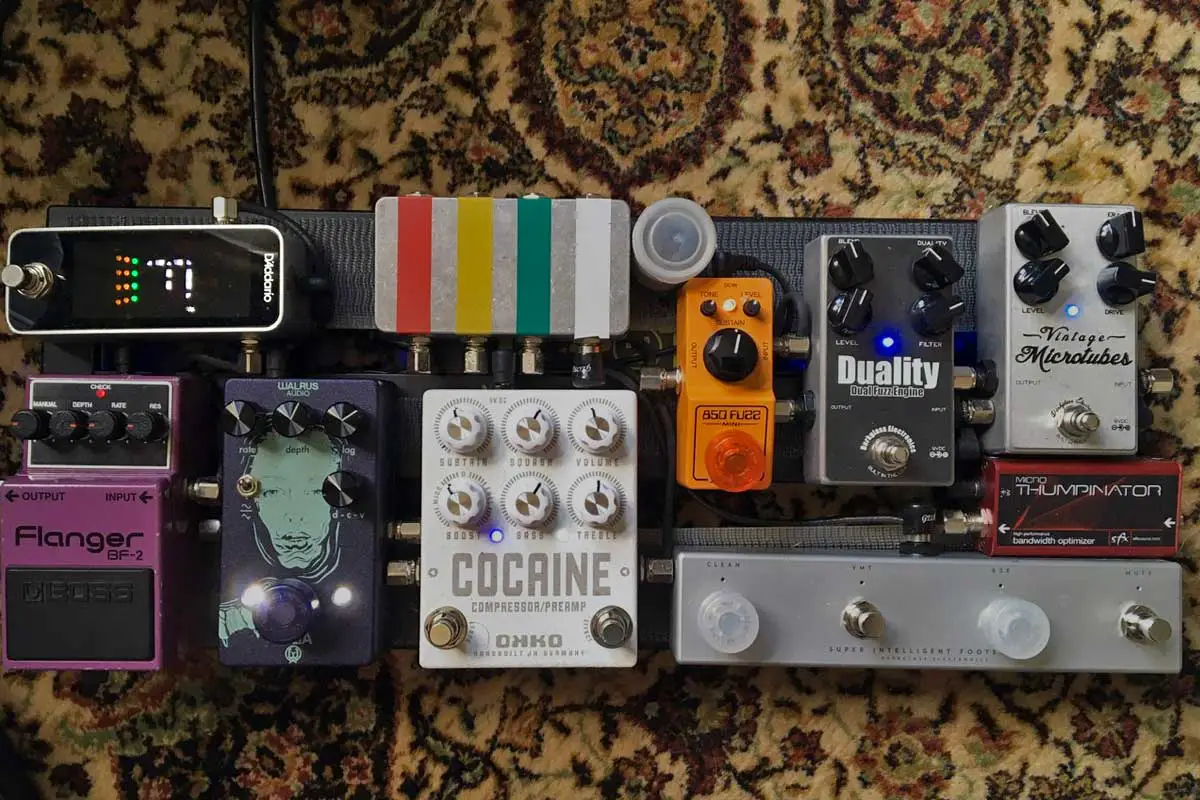
Top Tuner Pedals for Musicians
Tuning is crucial for any musician striving for a perfect performance, and a reliable tuner pedal is a godsend for guitarists and bassists alike. In our search for precision and efficiency, we have compiled a list of the best tuner pedals available on the market. These models are celebrated for their accuracy, ease of use, and durability, ensuring that you can focus on playing your best while staying perfectly in tune. Whether you’re rehearsing at home, recording in the studio, or live on stage, these tuner pedals are up to the task.
D’Addario Pedal Tuner

We’d recommend this tuner pedal for its precise tuning and slim design, making it a practical addition to any pedalboard.
Pros
- Highly accurate with fast note detection
- True bypass maintains signal integrity
- The vibrant display is easy to read in various lighting conditions
Cons
- Lacks an additional power outlet for daisy-chaining other pedals
- Some may find it less responsive compared to other high-end models
- The footswitch click can be noticeably loud in quiet settings
After adding the D’Addario Tuner Pedal to our setup, we immediately noticed its sturdiness and the sleek aluminum housing—it feels built to last. Tuning is a breeze even in darker venues, thanks to the pedal’s bright, colorful display. The true bypass is a boon for tone purists, ensuring that nothing gets in the way of our sound.
Striking a balance between a compact form factor and readability, this pedal has earned a permanent spot on our pedalboard. It doesn’t take up much real estate, which is invaluable as our board grows. Plus, the wide calibration range contributes to a more refined tuning experience across various instruments.
Our time with the pedal revealed a minor drawback: the absence of a power output to link additional pedals, which other tuners sometimes offer. Nonetheless, its core function—precision tuning—hasn’t failed us during gigs. The footswitch’s audible click might draw attention in a studio setting, but it’s never been an issue on stage amidst the mix. Overall, our experience tells us that this tuner’s reliability and simplicity make it a sound choice for musicians of all levels.
TC Electronic POLYTUNE 3 MINI
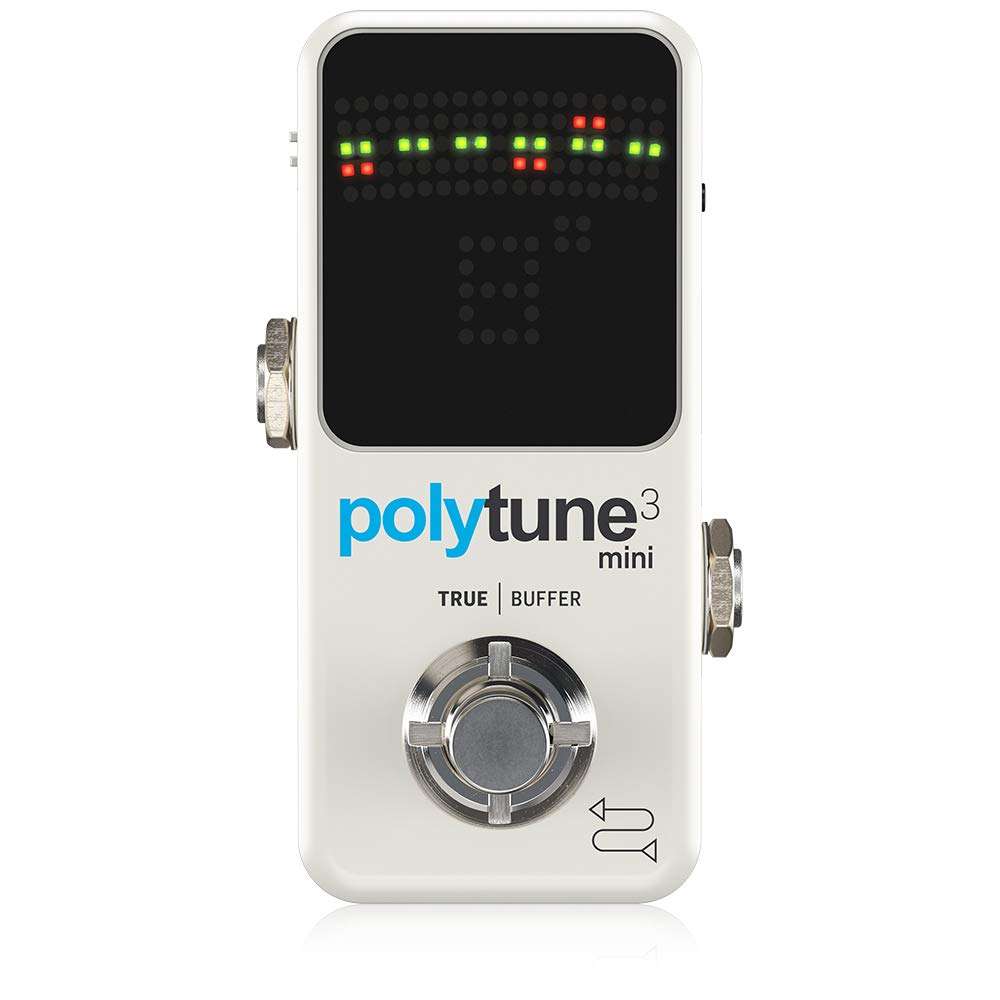
After several gigs and studio sessions, we can confidently recommend the TC Electronic POLYTUNE 3 MINI for its reliable and swift tuning capabilities.
Pros
- Tunes all strings simultaneously, speeding up the tuning process
- The built-in buffer maintains signal integrity even through long cable runs
- Compact size conserves precious pedalboard space
Cons
- The display can be susceptible to scratches
- Might be too small for those who prefer larger footswitches
- Limited functionality compared to larger tuning pedals
Our stage setups have never been more streamlined since we added the POLYTUNE 3 MINI to our pedalboards. The polyphonic tuning feature has been a game-changer during live performances. One strum, and we immediately know which strings need adjustment. That alone has saved us countless moments between songs.
The built-in Bonafide buffer is a godsend, preserving the tone of our guitars as if we were plugged directly into the amp. It’s noticeable, especially for those of us who love using several pedals in our signal chain. With this tuner, our signal’s soul remains intact, even through a complex setup.
As for its size, we’ve yet to find a more space-efficient tuner that doesn’t sacrifice functionality. It’s remarkable how such a small device packs such a punch. Although, it’s worth noting that sometimes we yearn for a slightly larger display and footswitch, but this is a small trade-off for an otherwise sterling piece of kit.
In conclusion, the POLYTUNE 3 MINI has earned its place on our pedalboards. Its minor drawbacks don’t overshadow the convenience and quality it brings. Whether we’re playing an intimate acoustic set or rocking a crowded venue, it’s the tuner we trust.
Boss TU-3 Tuner
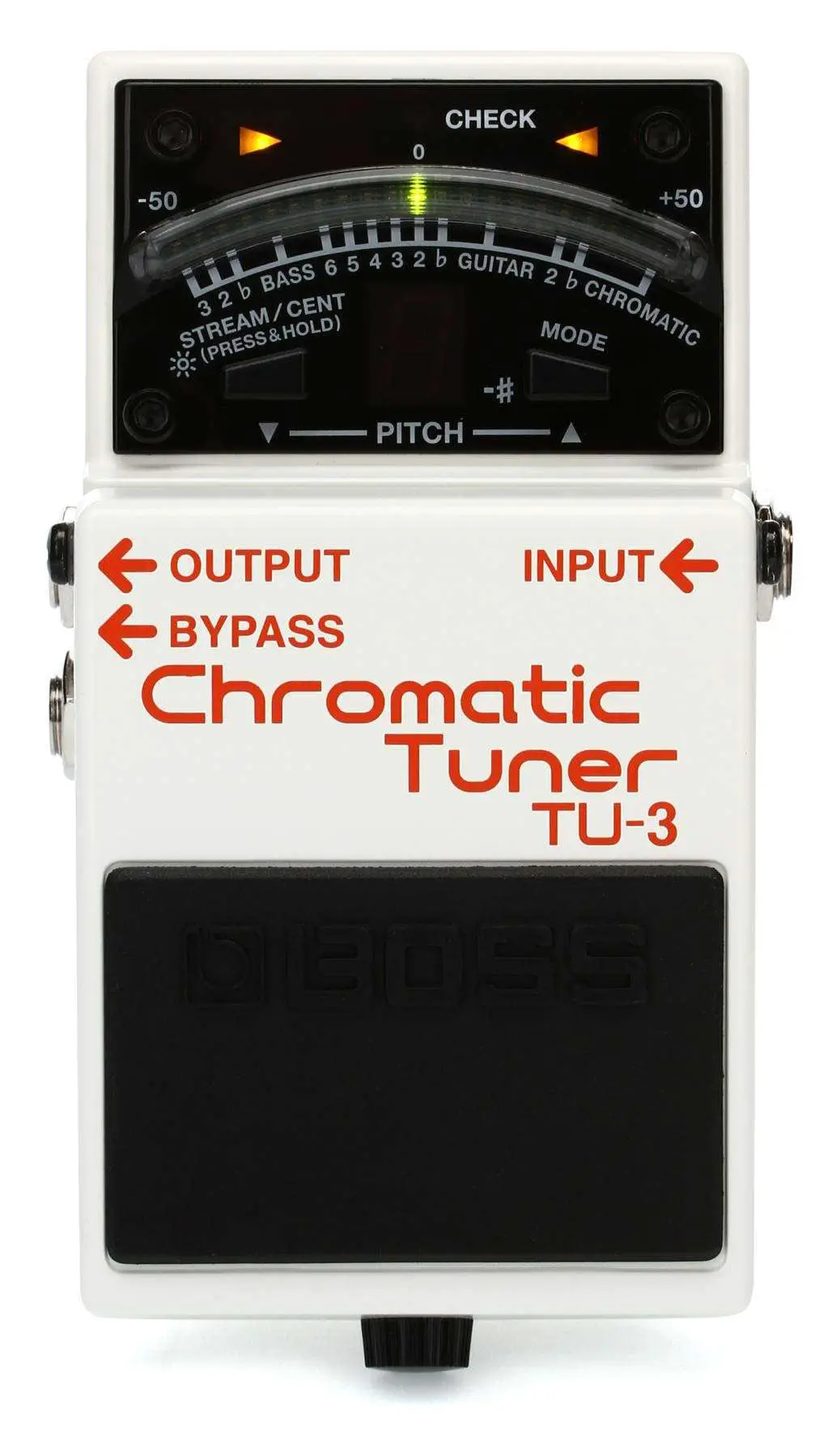
We believe you’ll find the Boss TU-3 to be an essential tool for maintaining pitch-perfect performance with its robust build and precision.
Pros
- Exceptionally durable and reliable for frequent gigging
- Bright display offers excellent visibility in various lighting conditions
- Accurate tuning with swift response makes it a go-to for quick adjustments
Cons
- Higher price point compared to entry-level tuners
- Requires power supply or batteries, which could be inconvenient for some
- Might be more tuner than a casual player needs
When we recently took the Boss TU-3 out for a spin, it didn’t disappoint. Tuning our guitars in a noisy venue was a breeze, thanks to the tuner’s high-brightness mode, which easily cut through the ambient light. The smooth 21-segment LED meter is not just for show; it made the tuning process intuitive and satisfying.
On a technical gig, versatility is key. The TU-3 didn’t let us down when we shifted to dropped tunings. Selecting the flat tuning up to six semitones below our standard pitch provided the raw, lower edge we needed without compromising tuning accuracy.
The final touch that bolsters our confidence in the TU-3 is its muted tuning. The ability to tune silently between songs is a mark of professionalism. While the cost might raise an eyebrow, consider it an investment in reliability and stage-readiness. This pedal withstands the rigours of the road and keeps you in perfect tune, gig after gig.
Ibanez BIGMINI Tuner
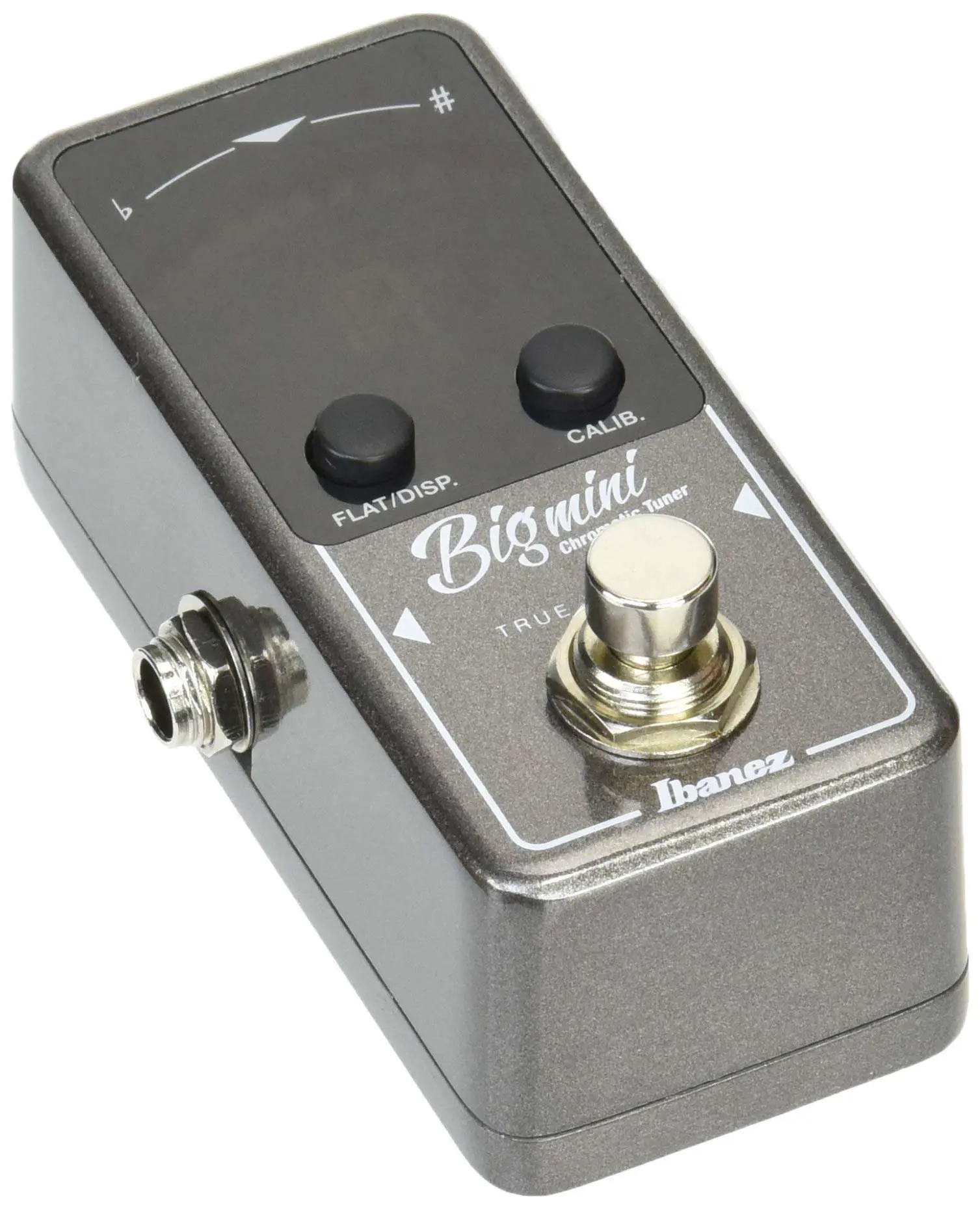
We found the Ibanez BIGMINI tuner to be a reliable tool that strikes a balance between accuracy and compactness, perfect for musicians with crowded pedalboards.
Pros
- Extremely space-efficient design
- Accurate tuning from A0 to C8
- Calibration adjustability from 435Hz to 445Hz
Cons
- Screen might be too small for some
- No polyphonic tuning feature
- Limited visibility in brightly lit conditions
After plugging in our guitars, we noticed the BIGMINI’s swift response time. Its chromatic tuning was on point, letting us transition smoothly between songs with different tunings. The pedal’s compact footprint impressed us, leaving ample space for other effects on our pedalboard.
In a dimly lit venue, the display was crisp and easy to read. However, on a sunny day at an outdoor gig, it was a bit more challenging to see the tuner’s readout. Nevertheless, its rugged construction felt roadworthy, giving us confidence that it could withstand the rigors of touring.
Tuning was exact, even for the lower registers which can be problematic for some tuners. The option to calibrate the tuner gives it a slight edge, making it adaptable for various instruments. Although it lacks a polyphonic tuning feature, which some may miss, we found the straightforward, sharp performance of the Ibanez BIGMINI more than sufficient for our needs.
Donner DT-1
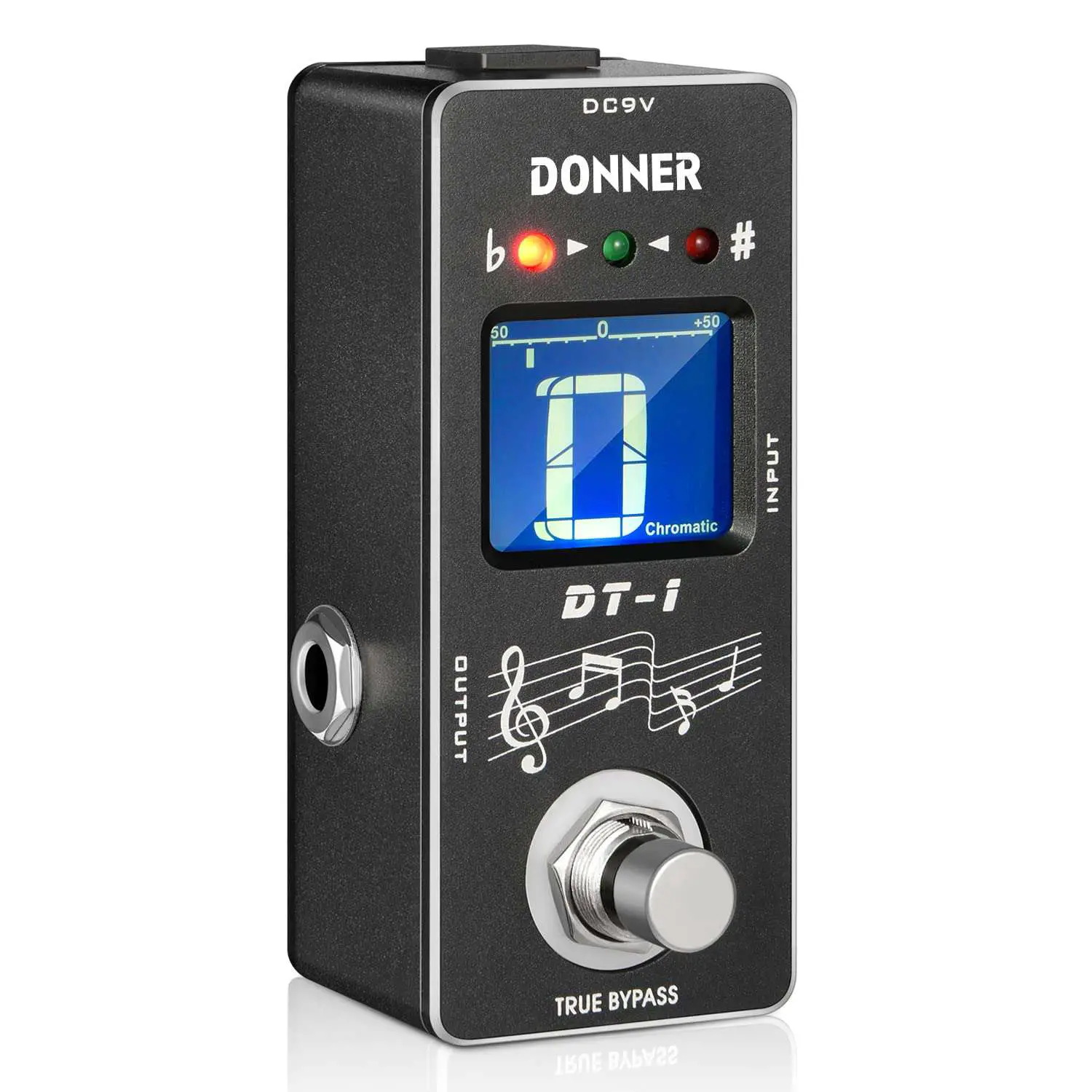
If you’re aiming for precision tuning with the convenience of a pedal, the Donner DT-1 is worthy of consideration.
Pros
- Seamless tuning with the noiseless true bypass feature
- Boasts a wide tuning range for versatile use
- Bright LED display ensures clarity even on outdoor stages
Cons
- Requires a separate purchase of a power adapter
- Limited to two modes which might not cater to all users’ needs
- Some may desire more features at this price point
Upon our first encounter with the Donner DT-1 Tuner Pedal, we were immediately struck by its sturdy build. It’s compact and doesn’t take up much real estate on the pedalboard, an essential factor for those of us who juggle multiple effects. Tuning electric guitars and basses with the DT-1 felt effortless and accurate, vital for ensuring our performances were pitch-perfect.
The tuner’s display is a standout feature, brightly lit and easy to read, which made tuning in dim-lit bars or sunny outdoor gigs a breeze. We also found the true bypass mode quite handy, maintaining our tone perfectly whilst we quietly tuned between songs.
Shortcomings are few but worth noting. One must remember to account for the added expense of a power adapter. Additionally, while simplicity is often an asset, some may find the two-mode operation limiting, especially if they’re looking for more advanced tuning capabilities.
In summary, the Doner DT-1 offers reliable performance in a tidy package. It’s clear why it’s a popular choice among musicians who value accurate, inconspicuous tuning without unnecessary complexity.
KLIQ TinyTune

We think the KLIQ TinyTune is an essential addition to any pedalboard for its reliable performance onstage and in the studio.
Pros
- Swift precision tuning
- Bright, visible screen
- Silent operation during tuning
Cons
- Requires external power source
- No additional tuning modes
- Limited features for advanced users
Stepping onto the stage, we immediately noticed how the vibrant display of the TinyTune cut through the dimly lit venue. It’s so easy to read; there’s practically no squinting required, even from a distance. You plug in, strike a string, and there it is—clear as day—a precise indicator of your tuning status.
Mid-performance, the last thing you want is a noisy pedal. We revel in the quiet confidence the TinyTune provides with its silent tuning feature, allowing us to tune without the audience hearing any distracting pops or buzzes. It’s a smooth, professional experience.
Durability isn’t a concern either, thanks to its rugged aluminum housing. We’ve stomped on it show after show, and it’s still going without a hitch. The TinyTune performs consistently, maintaining the integrity of our sound, which is precisely what we demand from our gear.
However, while the TinyTune is clearly built for simplicity and efficiency, those looking for a variety of tuning modes or extra features may find its straightforward design a bit too basic. It delivers on its promise of simplicity but maybe too simple for the tech-savvy musician.
Monoprice Chromatic Tuner

We find the Monoprice Chromatic Tuner is a solid choice for musicians seeking reliability without breaking the bank.
Pros
- Mutes signal when engaged, allowing discreet tuning
- Large, bright display is easy to read under any stage conditions
- Sturdy build and simple operation are a plus for frequent gigging
Cons
- Slight pop noise when activating may be noticeable in quiet settings
- Slow response time compared to some high-end tuners
- Lack of onboard battery can be inconvenient for some setups
This tuner’s metal construction exudes durability and seems ready to take on rigorous touring schedules. The activation button has a satisfying click, and we appreciate its true bypass feature which doesn’t alter our guitar’s tone.
On stage, the large display on this chromatic tuner stands out, even under various lighting conditions. It’s straightforward to use; a stomp is all it takes to mute your instrument for silent tuning, which we find very useful during live performances.
Despite its virtues, we do notice a slight ‘pop’ when activating the tuner. It’s not a deal-breaker but could be a minor annoyance in a studio or acoustic setting. Moreover, the response time might not match the speed of more expensive units, but it’s accurate enough for regular use. Remember, this pedal does not come with a battery or power adapter, so have your power needs sorted beforehand.
VSN LT-901 Pedal Tuner
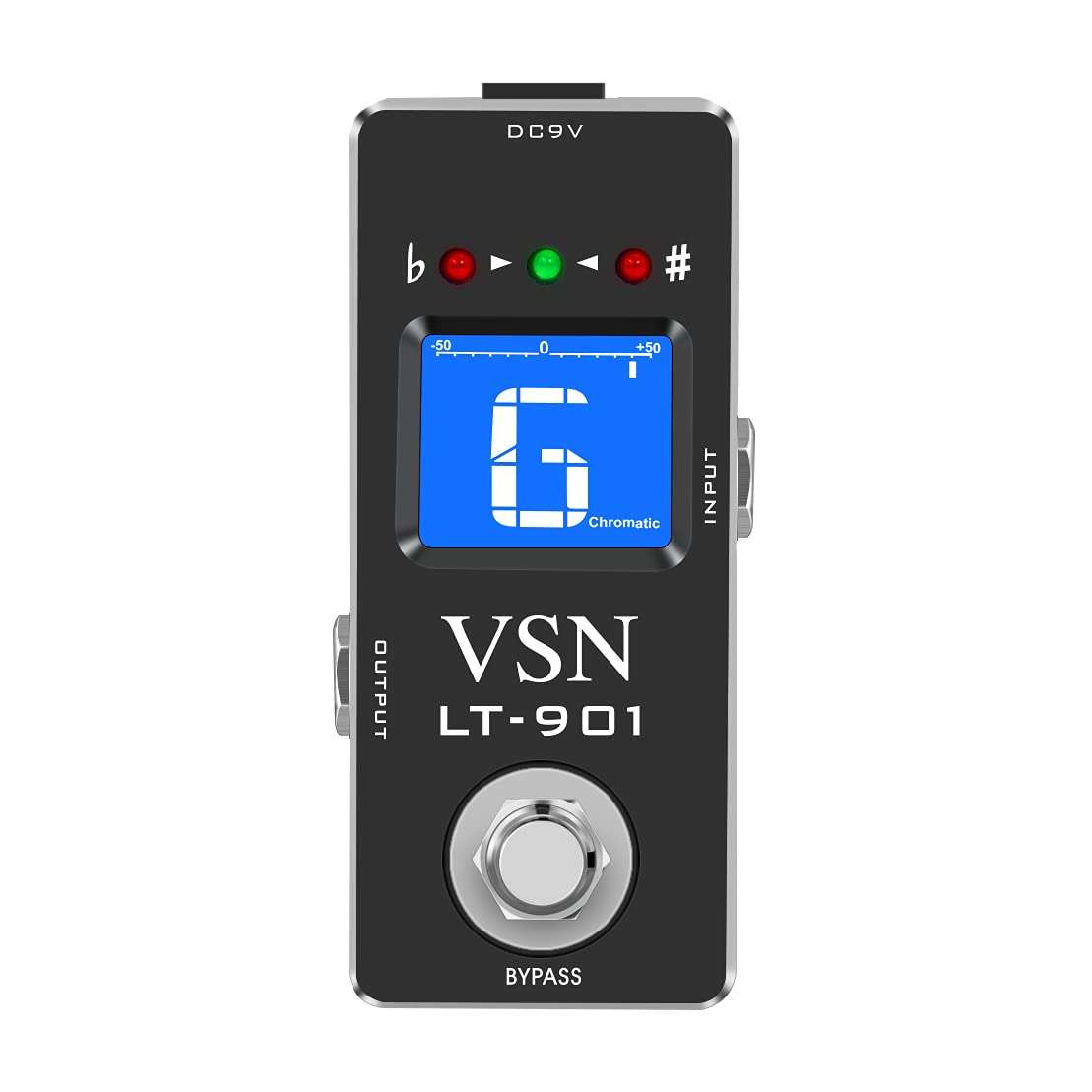
After strenuous testing, we can assert the VSN LT-901 is a trusty companion for any guitarist seeking a no-fuss, effective tuning experience.
Pros
- Bypass feature preserves signal integrity
- Bright LED and LCD provide clear visibility on dark stages
- Metal construction feels sturdy and road-ready
Cons
- Does not come with a 9V DC adapter
- LED lights may be excessively bright for some
- First-time users may experience a slight learning curve
Upon first use, we found the pedal’s true bypass feature highly reliable, ensuring our tone remained untainted when not actively tuning. The tuner engaged silently, a godsend during mid-gig adjustments. Even under dim lighting, the LED display shone as a beacon through the murkiest venues, making it a breeze to tune even in a pinch.
The rugged build of the LT-901 instilled confidence; it can withstand the rigors of the road with ease. The metallic body did not just survive a few accidental stomps; it shrugged them off, proving it’s a durable asset for any pedalboard.
On the other hand, we did yearn for an included power adapter, as this would have made it a complete package straight out of the box. Also, while the LEDs perform admirably under stage lights, their luminance might be overpowering in more intimate settings, but this is a minor quibble in an otherwise superb design.
Overall, we’d unquestionably keep the VSN LT-901 in our arsenal for reliable, precise tuning on the move. This modestly priced powerhouse punches well above its weight, simplifying a fundamental aspect of our performance.
Buying Guide
Key Features to Consider
When we look for the best tuner pedal, there are several features we should consider:
- Accuracy: This is the most critical aspect. Seek out tuners that offer precise tuning within +/- 1 cent for optimal performance.
- Display: The visibility of the display is crucial. A bright, easy-to-read display is beneficial, especially under different lighting conditions.
- True Bypass: This ensures that the pedal does not interfere with the signal when it’s not in use.
- Tuning Range: Ensure the pedal can tune to the range of instruments you’ll use it with.
Durability and Size
- Housing: A robust metal housing will last longer, especially for gigging musicians.
- Size: Consider how much space you have on your pedalboard. Compact pedals save space, but make sure they meet your functionality needs.
Tuning Modes
Some tuners offer different modes such as chromatic, strobe, or polyphonic tuning. Decide which mode suits your playing style best.
| Tuning Mode | Description |
|---|---|
| Chromatic | Detects all notes, allowing for versatile tuning |
| Strobe | High accuracy, can see the tuning in real-time |
| Polyphonic | Can tune all strings at once |
Power Requirements
Finally, check the power requirements of the pedal. Most operate on a standard 9V supply, but it’s best to confirm to avoid any incompatibility issues with your current setup.
By taking these factors into consideration, we can make an informed decision that suits our specific needs and ensure that our performances are always in tune.
